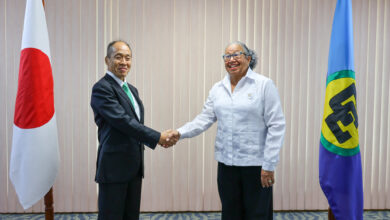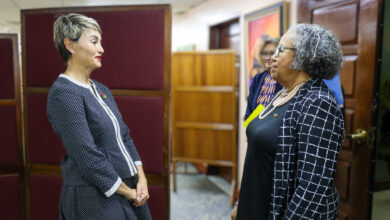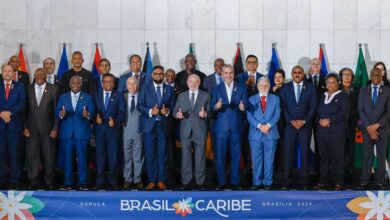|
Hon Said Musa, Prime Minister of Belize Climate change issues first gained prominence in the Global Small Island Developing States (SIDS) Conference held in 1994 in Barbados. This conference was organised under the auspices of the United Nations (UN) system to focus attention on environmental issues impacting on the development of SIDS and low lying coastal states such as Guyana and Belize. The major outcome of the Barbados meeting was the Barbados Programme of Action (BPOA) which identified a programme of activity designed to address critical issues which SIDS needed to address in order to ensure that this development takes place in an environmentally sustainable manner. Unanimously the conference identified the issue of climate change and its potential to severely disrupt the development efforts of SIDS and the low lying coastal states as a first priority. The BPOA called on Member States to seek ways in which they could increase their resilience to projected climate change impacts through adaptation. This decision reflects the concern of our countries that although we in the Caribbean are responsible for less than 1per cent of global green house gas emissions, (the accumulation of which in the atmosphere is thought to be the reason for observed changes in global climate), our countries are among the most vulnerable to the projected impacts of climate change especially sea level changing weather patterns and the increased severity of extreme events. As a result, Caribbean governments approached the Organisation of American States (OAS) and requested support to develop a regional project aimed at building capacity for adaptation to climate change. The OAS and CARICOM then organised a series of national and regional consultations and workshops designed to facilitate maximum stakeholder consultation on the formulation of the regional project. These efforts culminated in the articulation of a regional proposal for the Caribbean Planning for Adaptation to Climate Change (CPACC) project which was submitted to the Global Environmental Facility (GEF) for funding. Funding to the tune of $6.5M US was granted by the GEF for the implementation of CPACC. The project had three tiers of management. In keeping with the conditionalities of the GEF, oversight was provided by the World Bank as an implementing agency and technical support by the OAS as executing agency. Actual implementation was carried out by a Regional Project Implementation Unit based in Barbados, which I had the privilege to head. The CPACC project had as its objective the building of capacity in the Region for adaptation to climate change impacts, especially sea level rise, though vulnerability assessments and capacity building related to these. A Project Advisory Committee chaired by CARICOM provides technical advice and guidance to the RPIU. The CPACC project (1997-2001) was successfully implemented and was responsible for inter alia the establishment of a CARICOM wide network of monitoring stations, development of regional capacity for coral reef monitoring, vulnerability assessments, economic valuation of environmental services, the articulation of national climate change adaptation policies and implementation plans and an enhanced public awareness of climate change issues in the Region. Germane to today’s proceedings however was the realisation among those involved that the climate change problematique+– needed to be addressed through a long term programmatic strategy and not through a piecemeal project by project approach. To facilitate this, the Region would require to, as far as possible endogenise the institutional arrangements for the implementation of climate change activities and moreover place these on a more sustainable footing. This realisation marked the genesis of the idea of the Caribbean Community Climate Change Centre, an idea which had its birth and evolution at the level of the Project Advisory Committee and full support from it’s chair Asst. Secretary-General Byron Blake and members such as Professor Al Binger, the then Director of UWICED, and Dr Leonard Nurse, the then Permanent Secretary in the Ministry of Environment, Barbados. From its very inception we also received the unstinting support from the then task manager for the project in the World Bank, Walter Vergara. The idea of the Center gained momentum and received full support from countries in the Region through the advocacy of CPACC’s national focal points. Articles of Association for the Center were developed by the then legal counsel for CARICOM, now the Honourable Justice Mr Duke Pollard a recent appointee to the Caribbean Court of Justice (CCJ). Through the initiative of the Assistant Secretary-General., climate change and other environmental issues were regular features on the agenda of the Council of Ministers responsible for Trade and Economic Development (COTED). The proposal to establish the Center was approved by COTED in January 2001 and the Articles of Association by the CARICOM Legal Council in September 2001. In proposing the establishment of the Center to COTED, those of us responsible took a “leap of faith” in that we gave the council and the Region the assurance that unlike other regional institutions, the Centre will not seek “subventions” from countries for its support. Today’s ceremony, formally opening the Centre is justification for that “leap of endorsed the proposal to establish the climate change center and the Government of Belize offered to host it. This explains our presence here today. Before the completion of CPACC, the Region successfully negotiated a $3.5M Cdn. Grant from the Canadian Climate Change Development Fund. This grant provided support for a three year project (2001-2004) the Adapting to Climate Change in the Caribbean (ACCC) project which was designed to build further capacity for climate change adaptation in the Region. The ACCC project fully supported the further evolution of the institutional arrangements for the Center through the provision of resources to develop a business plan for it. The plan provides a comprehensive strategy for ensuring the financial sustainability of the Centre. I am also proud to observe that under the skilful leadership of the incumbent Director, Dr Ken Leslie some of the ideas articulated in the business plan have come to life. During the tenure of the ACCC, project negotiators were successfully completed with the GEF for a follow up regional project-the Mainstreaming the Adaptation to Climate Change (MACC) project which we are now implementing (2004-2007). Under the Canadian project execution was carried out by CARICOM, the latter replacing the OAS which as pointed out earlier was the executing agency for the CPACC project. Our present project the MACC is again implemented by the World Bank in keeping with GEF requirements. Execution is by CARICOM and day to day implementation by a small unit, which I again have the privilege of leading, and operating out of the premises of the Climate Change Centre here in Belmopan. Quite recently, the Region has again successfully negotiated a grant from the GEF to develop a pilot adaptation project in the islands of St Lucia, Dominica and St Vincent and the Grenadines. A small but significant change in the arrangements for the execution of this pilot project is noteworthy. Implementation is again under the auspices of the World Bank, but the Climate Change Center now assumes responsibility for its execution, instead of CARICOM. This vote of confidence of both the World Bank and CARICOM in the ability of our fledgling institution to function as an executing agency for GEF funded projects is a significant milestone in the evolution of the Centre as a “Centre of excellence” in the Caribbean region.
It also serves to move us closer to the realisation of our earlier intent to endogenise the regional institutional arrangements for addressing climate change issues and to place these on a sustainable footing. We look forward to the continued support of our governments and people to ensure the future success of this bold experiment. |
|
|
|
Caribbean Community Climate Change Centre (CCCCC)Institutions within the CommunityMainstreaming Adaptation to Climate Change (MACC)Press Releases





